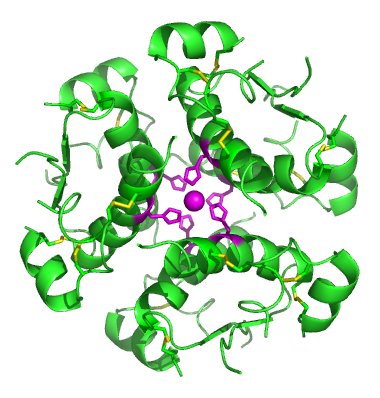Hyperinsulinemic Hypoglycemia, Familial, 2

A number sign (#) is used with this entry because familial hyperinsulinemic hypoglycemia-2 is caused by mutation in the gene encoding the Kir6.2 subunit of the inwardly rectifying potassium channel (KCNJ11; 600937).
For a phenotypic description and a discussion of genetic heterogeneity of hyperinsulinemic hypoglycemia, see HHF1 (256450).
Clinical FeaturesNestorowicz et al. (1997) reported a Palestinian Arab boy, born of first-cousin parents, with severe hyperinsulinemic hypoglycemia diagnosed immediately after birth, which failed to respond to medical treatment with either diazoxide or the somatostatin analog, octreotide, and required near-total pancreatectomy to control hypoglycemia. From birth, he had severe vomiting and diarrhea of unknown etiology, which precluded oral feedings for the first 18 weeks of life, but which subsequently remitted. Nestorowicz et al. (1997) noted that they had observed a similar digestive problem in a patient with hyperinsulinism due to mutations in the ABCC8 gene (600509; see also HHF1, 256450) and stated that this patient was clinically indistinguishable from patients with severe hyperinsulinism caused by mutations in the ABCC8 gene. At age 3.7 years, he had no gross evidence of any neurologic, neuromuscular, or cardiovascular abnormality.
Focal Adenomatous Hyperplasia
Fournet et al. (2001) reported 4 patients with hyperinsulinemic hypoglycemia due to focal islet cell adenomatous hyperplasia with specific loss of maternal 11p15 region and a paternally inherited mutation of the KCNJ11 gene.
Taneja et al. (2009) reported a Swedish patient with hyperinsulinemic hypoglycemia due to focal adenomatous hyperplasia. Resection of the focal hyperinsulinemic area of the pancreas resulted in clinical cure of the patient. They noted that the paternal mutation (600937.0022) affected an endoplasmic reticulum (ER) exit signal in the KCNJ11 gene.
Molecular GeneticsThomas et al. (1996) screened genomic DNA from members of 15 families with hyperinsulinemic hypoglycemia for mutations in the KCNJ11 gene. In a male infant with profound hypoglycemia, born of consanguineous Iranian parents, Thomas et al. (1996) identified homozygosity for a 649T-C mutation (600937.0001). His parents were heterozygous for the mutation.
Using SSCP and nucleotide sequence analysis, Nestorowicz et al. (1997) screened 78 patients with hyperinsulinism for mutations in the KCNJ11 gene and identified homozygosity for a nonsense mutation (600937.0009) in a Palestinian Arab boy.
In an Israeli Bedouin infant and an Arab infant with hyperinsulinemic hypoglycemia, Tornovsky et al. (2004) identified homozygosity for a mutation in the promoter (600937.0010) and in exon 1 (600937.0011) of the KCNJ11 gene, respectively.
In an infant that presented with macrosomia at birth and severe hyperinsulinemic hypoglycemia, Marthinet et al. (2005) identified a homozygous missense mutation in the KCNJ11 gene (H259R; 600937.0013). Despite medical treatment, the newborn continued to suffer from severe hypoglycemic episodes, and at 4 months of age subtotal pancreatectomy was performed.
Henwood et al. (2005) measured acute insulin responses (AIRs) to calcium, leucine, glucose, and tolbutamide in 22 infants with recessive ABCC8 or KCNJ11 mutations, 8 of whom had diffuse hyperinsulinism and 14 of whom had focal hyperinsulinism. Of the 24 total mutations, 7 showed evidence of residual K(ATP) channel function: 2 of the patients with partial defects were homozygous and 4 heterozygous for amino acid substitutions or insertions, and 1 was a compound heterozygote for 2 premature stop codons.
Pinney et al. (2008) identified 14 different dominantly inherited K(ATP) channel mutations in 16 unrelated families, 13 with mutations in the ABCC8 gene (see, e.g., 600509.0011) and 3 with mutations in the KCNJ11 gene (see, e.g., 600937.0020). The 16 probands presented with hypoglycemia at ages from birth to 3.3 years, and 15 of 16 were well controlled on the K(ATP) channel-agonist diazoxide. Of 29 adults with mutations, 14 were asymptomatic, and only 4 had diabetes. Unlike recessive mutations, dominantly inherited K(ATP) mutant subunits trafficked normally to the plasma membrane when expressed in simian kidney cells; dominant mutations also resulted in different channel-gating defects, with dominant ABCC8 mutations diminishing channel responses to magnesium adenosine diphosphate or diazoxide and dominant KCNJ11 mutations impairing channel opening even in the absence of nucleotides. Pinney et al. (2008) concluded that there are distinctive features of dominant K(ATP) hyperinsulinism compared to the more common and more severe recessive form, including retention of normal subunit trafficking, impaired channel activity, and a milder hypoglycemia phenotype that may escape detection in infancy and is often responsive to diazoxide medical therapy.
Bellanne-Chantelot et al. (2010) analyzed the ABCC8 and KCNJ11 genes in 109 diazoxide-unresponsive patients with congenital hyperinsulinism and identified mutations in 89 (82%) of the probands. A total of 118 mutations were found, including 106 (90%) in ABCC8 and 12 (10%) in KCNJ11; 94 of the 118 were different mutations, and 41 had been previously reported. The 37 patients diagnosed with focal disease all had heterozygous mutations, whereas 30 (47%) of 64 patients known or suspected to have diffuse disease had homozygous or compound heterozygous mutations, 22 (34%) had a heterozygous mutation, and 12 (19%) had no mutation in the ABCC8 or KCNJ11 genes. The authors noted that there appeared to be a predominance of paternally inherited mutations in patients diagnosed with a diffuse form of disease and carrying heterozygous mutations.